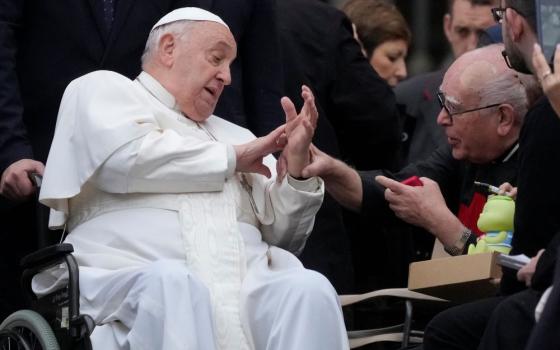As Catholics awaited the choice of their next Communicator in Chief, hundreds of Protestants radio and television evangelists were in Nashville grappling with new challenges to spreading the Word in a dizzyingly electronic age.
Benedict XVI's experiment with Twitter is a small but graphic sign or how urgent the task of finding new ways to reach the washed and the unwashed has become in diverse parts of the Christian universe. Behind the urge is anxiety that if Christians don't keep up with the times, the churches could be left behind to languish.
For the Nashville assembly of the National Religious Broadcasters, the pressing issues were how to keep their radio, television and Internet ministries competitive after losing their edge. Broadcast evangelism goes back to the earliest days of radio and has never ceased being a staple of the AM radio band. The impulse that drives it is as old as Christianity itself -- to preach the Gospel to the ends of the earth. In so doing, evangelists prefigured free enterprise as steadily proliferating voices outdid each other to convert unbelievers. The Coca Cola phenomenon would be inconceivable without missionary fever having provided a sales template.
Not long ago, this group of evangelicals would use their convention to display their brands and exult in the accomplishments of programming that fit a long dominant, straightforward format of preaching and church singing in remote radio studios or standard television sets. Those were the days of big names like Jerry Falwell, Oral Roberts and Billy Graham whose presence was unmistakable. Presidential candidates like Richard Nixon and Ronald Reagan sought their blessing and many of their members shared a stage with powerful political operatives.
Most religious broadcasters, by contrast, are personable, unassuming bearers of the Gospel, existing in modest, often minimal surroundings They devote themselves to evangelizing the uncommitted often sacrificing income and professional alternatives to keep their calling.
For a time, their boats rose in the evangelical tide that swept the nation. As the heyday of evangelical attention and growth subsided in the wake of scandals ousted well-known televangelists like Jim Bakker, -- the the normal ebb and flow of religious sentiments -- preachers like Joel Osteen have come along on increasingly sophisticated platforms, but the "star system" of the NRB has faded.
For local and regional media outlets, the relative slump in evangelism has combined with the recognition of the irrelevance of traditional programming to force hard choices.
Chief among the complicating factors is the demands made by the digital revolution which has fragmented the religious audience as much as any other. NRB audiences heard a series of speakers insisted that their survival depended on utilizing Facebook, Twitter, YouTube, archived web sites and a host of techniques to play across this collection of tools. The goal that increasingly is heard from speakers and listeners alike derives from social media: reach viewers and listeners with any or all the resources that a fully equipped producer would presumably have -- and find the means of engaging with them.
The pressure to build community among audience members stands largely in contrast to the practices of the past. In the older model, respondents to radio and television ministries were encouraged to send financial support but otherwise the communication was one way. Part for financial reasons but largely for reasons of pastoral care, broadcasters are attempting to build two-way bridges with listeners but ties among listeners themselves. Some offer counseling to one degree or other and others, though attached social media, make possible continuing conversation.
It's a tall order which is an exciting challenge to some broadcasters, even those who currently lack personnel or funds to carry out the new mandate, and a dead end for others. One radio broadcaster reported sitting among a group of radio preachers who foresaw the end of such ministries in the face of obstacles they regarded as insurmountable.
Meanwhile, the convention exhibit center was a showcase of technology for those determined to grasp its potential as a means of saving souls in more effective and meaningful ways.
Such hopes accord with a trend toward personalized Christianity which draw on Internet and social media fragments. Some church leaders worry that this "cyber Christianity" even with intermittent electronic contact, is at odds with the basic assumption that Christians are nurtured in and through their participation in a face-to-face community
For Catholic and Protestant communicators alike, that is perhaps the issue of greatest consequence. If the new mission to build a cyber faith succeeds, what will result from that?



